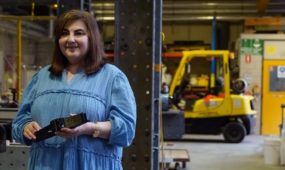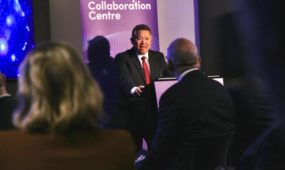Time to talk about the future
Research & Development
GETTING experts out of bed in the middle of the night to discuss the concept of time is just one of the ways a leading South Australian futurist provokes people to think differently about the world.

Sign up to receive notifications about new stories in this category.
Thank you for subscribing to story notifications.
Kristin Alford, the founding director at Bridge8 is co-hosting the ‘Chronference: An experimental, pop up time travel symposium’ (#chron02014) that runs from 4.42am until 8.17am on Tuesday September 23rd 2014 In Melbourne, Australia
“Speakers with backgrounds in science, architecture, visuals arts, psychology, business and foresight will present different perspectives on the past, present and future,” Kristin said.
“We want to trigger conversations and reconsider how we think about time and futures,” she said.
As a futurist, Kristin uses an approach called strategic foresight.
“In thinking about foresight, we use the metaphor of time being like a river,” she said. “You don’t know what the river might hold, you’re not sure when the current will switch, you’re not prepared for a freak tidal influx, you don’t know who you’ll be travelling with and perhaps you’re unaware of what tools you’ve got on board.”
Futures frameworks and processes can be used to guide people through consideration of not just the techno-centric aspects of the future – like robots and hover-boards – but also other elements, such as the environment, resource management, health, sociology and politics.
Strategic foresight is a way of structuring your thinking so that you can create the future that you want
Often this involves veering off the well-trodden path to explore unexpected or even uncomfortable scenarios.
Bridge8 facilitated the long-range Living Scenarios: Australia 2050 project with the Australian Academy of Science.
Professor Michael Raupach is Director of the Climate Change Institute at Australian National University, and led Phase 1 of the project involving group workshops with 35 scientists.
“We wanted to look at environmental and equity outcomes towards 2050,” said Professor Raupach. “Kristin was brought in to be the rapporteur; to bring together all the thinking of the group and unite it to form a piece of written work.”
In the second phase, 70 people from diverse backgrounds were asked to think through four possible future archetypes for Australia: a growth scenario, a restraint scenario, a collapse/catastrophe scenario and a transformation scenario.
“Kristin was pivotal in leading that exercise,” said Professor Raupach.
Outcomes from Living Scenarios: Australia 2050 have been published on The Conversation and Solutions and Journal of Future Studies [PDF].
The City of Adelaide is using a structured approach to consider its future through the Picture Adelaide 2040 project.
“Kristin from Bridge8 was engaged by Adelaide City Council to facilitate future thinking workshops with the executive team and community,” explained Adelaide City Council CEO Peter Smith.
“Kristin used strategic foresight to help us find the new narratives and stories that could be told through exploring the plausible, possible and preferred futures for the City,” he said.
South Australian Department of State DevelopmentMusitec
David Grice is managing director at Musitec.
In addition to facilitation and outcome management through guiding structured conversations, Bridge8 also develops visuals and animations as tools for foresight and futures thinking. James Hutson is the company’s animation specialist.
“We created a series of 6 critical thinking videos for the Commonwealth Government TechnYou resource,” said Kristin. “These were designed to be starting points for conversations.”
“The hypothesis was that part of the reason that people found it difficult to talk around contentious issues – like biotechnology, nanotechnology and genetically-modified organisms, or GMOs – was that they actually didn’t have the critical thinking skills to enable them to do that,” she said.
“Of course it’s not the only factor that would play a part, but the thinking was ‘if people could think more critically, would that help them better consider these technologies, and talk about the roles these might play in our future?’ ”
Other Bridge8 animations tackle This Thing Called Science (for TechnYou), Emerging Technologies (for TechnYou), Grow a Better Future (for Oxfam) and Hips for Hipsters (for Research my World).
“Our animations are 2-dimensional, they’re simple, they allow the viewer to project their own thoughts onto them,” Kristin explained. “We design them as a starting point for discussions.”
Bridge8 is also collaborating with Brisbane-based firm E-connect to deliver social media training for scientists in Australia and Poland.
“Funded initially by the Inspiring Australia initiative, this project was designed to get scientists familiar and comfortable with social media as a way for communicating,” said Kristin.
In addition, Bridge8 is working on projects in natural resource management and health in Australia.
[View the story “Chronference #chron02014” on Storify]
Jump to next article



